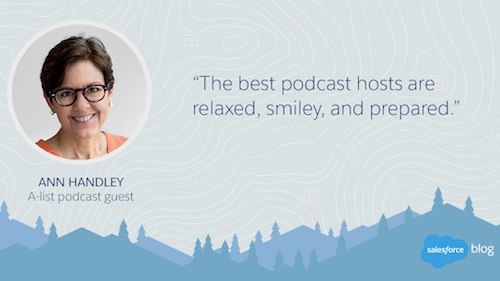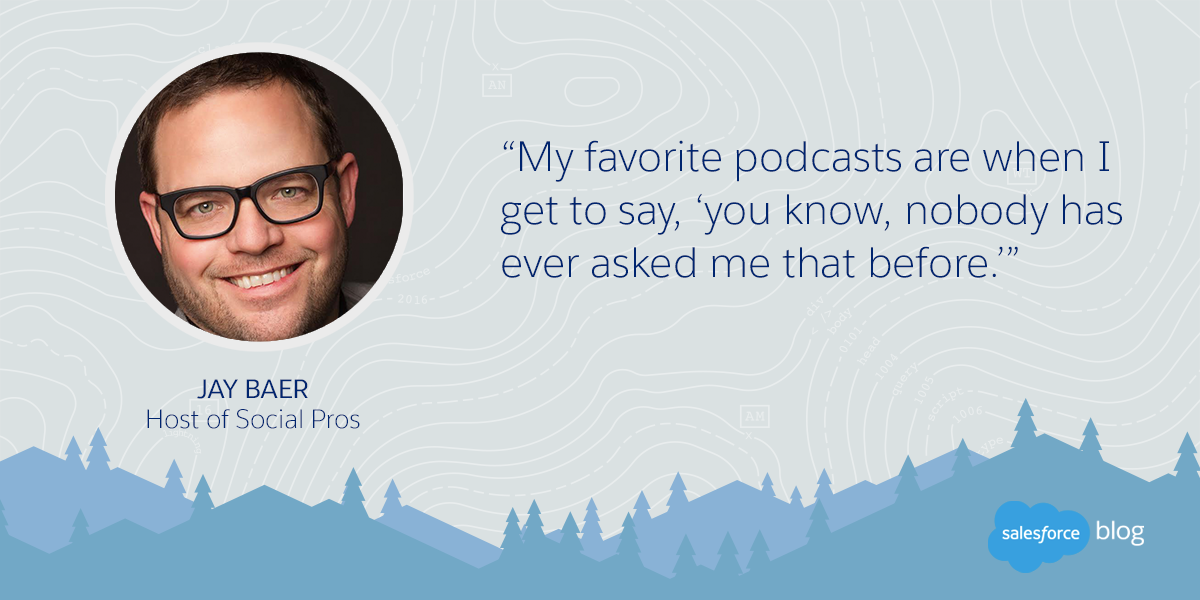The Logistics of Starting a Podcast: Recording, Interviewing, and Blanket Forts



So you want to start a podcast for your company. Maybe it’s an educational podcast for your customers. Maybe it’s all about sharing industry news. Whatever your goals, you’ve got some logistics to ponder. As the co-host of Salesforce’s Marketing Cloudcast — the marketing podcast from Salesforce —
So you want to start a podcast for your company. Maybe it’s an educational podcast for your customers. Maybe it’s all about sharing industry news.
Whatever your goals, you’ve got some logistics to ponder. As the co-host of Salesforce’s Marketing Cloudcast — the marketing podcast from Salesforce — I’m frequently asked questions about basic podcast interviewing, recording, and uploading.
I’ve got some tips to share, and I’ve also sourced tips from these tremendously talented podcast hosts and guests:
- Jay Acunzo, host of Unthinkable
- Jay Baer, host of Social Pros
- Andy Crestodina, host of Content Matters
- Ann Handley, A-list podcast guest
- Jess Ostroff, host of the Managing Editor Show
But before you dive into recording, think long and hard about your goals before the microphone ever starts recording. Start with my recent post, How to Start a Podcast: Your First Steps and Strategy.
Podcast Interviewing Tips
Fixin’ to have an interview-style podcast show? All the experts I talked to said the best podcast interviewers bring unique questions to the table, along with their own personalities.
Ann Handley says the best podcast hosts are “relaxed, smiley, and prepared.” She breaks down what that means:
- “‘Relaxed’ comes across in two ways: first, we spent some time prior to recording just chatting. And second, he or she wasn’t so focused on asking the next question on their list that they couldn’t just relax into the conversation at hand. So: less interview; more conversation. Less script; more organic.
- ‘Smiley’ means that he or she was having fun. They were enjoying the conversation. You could feel the smile… in other words. We could joke and laugh because, again, they weren’t too focused on hurry up and get to the next question already.
- And ‘prepared’ is just… prepared. Do your homework. You’d like to think this goes without saying, wouldn’t you? Yeah. Me, too. I’d like to think everyone knows not to ask me about the time I founded ‘MarketingSherpa.’ (True story.)”

Jay Baer agrees wholeheartedly on the preparedness front, with a twist. He says, “The best podcast experiences are when the host(s) have clearly done some homework and research on who you are and what you do, but also ask questions that you aren’t expecting. My favorite podcasts are when I get to say ‘you know, nobody has ever asked me that before.’”

Jay Acunzo says that being an expert podcast interviewer is all about respect: respect for both your audience and your guest. According to him, the best podcast interviewers “told me who the audience was and what they cared about. We’re talking not only to each other but to a swath of humanity that is a total mystery to me as a guest … unless the host helps me understand how to better tailor my answers.”
Interviewing is about more than your podside manner, though. What about the questions you ask? Acunzo continues, “For the love of all things marketing, DO NOT ask your guest to come up with the topics. I know it feels like a courtesy, but adds work to their plates and, most importantly, it’s your show. If your guest doesn’t give you something your audience loves, as the host/producer, that’s your fault, not the guest’s.”
Don’t forget your personality. This is a podcast, not a police interrogation. Acunzo says great podcasters he’s talked to “joked or caught up informally first. Even as a professional podcaster, this still helps me set my ‘natural’ voice and sound better in my answers.”
So how do you get the best content for your show from the people on the other side of Skype and the mic?
Jay Acunzo says, “Personally, I always ask guests if they have any pets, because they either light up and talk excitedly and casually (after which I launch into the recording) — or there’s a story they can share about why they don’t want any varmints running around. Either way, they become human, not quote-machines.”

Your podcast guests are real people, so it’s important to talk to them that way.
Jay Baer warns, “Do not fully script your show! I understand that podcasters are sometimes more comfortable adhering to a very tight format and structure, but for me it sucks all the spontaneity and magic out of the show when you ask the exact same questions, in the same sequence, to every guest. Might as well turn on ‘podcast host robot at that point!”
On the other hand, if you’re not doing an all-interview show, you may consider a working script so that you and your co-host don’t miss any important points. Jess Ostroff advises that this type of script “means that we can make our points more succinctly and not ramble so much (which I know I tend to do!). I don’t recommend this for every kind of podcast, but it’s worth trying if you’re doing something other than an interview-format show.”
One easy way to make your interviewing and podcast process easier: work in batches. According to Jess, “Batch preparing, batch editing, but especially batch recording makes a world of difference. Why? Well, if you’re anything like me, it takes a while to get out of the head-down-work-mode and into podcast banter mode.”
Your mood and level of interest and engagement come through in your voice. As a podcaster, get used to it, and make the most of it. She continues, “Getting your head in the zone and batching your processes makes a huge different in the quality of the podcast.”

You’ll have an easier time finding an audience if your podcast is unique. Your guests listen to your voice, quirks, and personality week after week, so make sure that the “self” you put out there is honest and singularly you.
Podcasting Logistical Tips
Now that you have the content down, do you know how you’ll edit it down to something listenable and share it with the world? Start with these logistical tips.
Podcast hosting: You need to create an RSS feed for your show. Libsyn is a service that creates your RSS feed so people can subscribe and get every episode when it’s released. Libsyn sends iTunes, Stitcher, and other services your content. I use the plan that costs $20 a month.
Podcast recording: Skype + eCamm is a great combination. If you’re doing an interview show with guests, Skype is easy because most guests already have it. Zencastr is another option.
Microphone for hosts: You can spend anywhere from $15-$15K on microphones, headsets, and equipment. Some hosts want a portable mic if they travel often. Some folks record in a studio; others don’t. The sky is truly the limit when it comes to what you want to spend.
A lot of podcasters use a Blue Yeti (around $120) or Audio Technica AT2020 (around $90). You can also check out Sennheiser PC8 (around $40) for something cheaper. Finding the right mic will be trial and error, depending on the sound quality in your space.
I recommend buying from Amazon, a mic company’s official site, or anywhere that has a great return policy. I bought a couple expensive mics before I actually settled on something much cheaper. Why? I record in an all-hardwood-floor space, and the nicer mics pick up too much of the space’s hollow, echo-y sound.
Microphone for guests: Have budget to send your guests a microphone? I suggest a Sennheiser PC8 or Logitech ClearChat USB Headset.
Audio editing: I used to do this myself for free in the early days of our show. I used Adobe Audition. You can also use GarageBand, which comes standard on every Mac. I also recommend checking out Levelator to adjust your levels.
If you decide to have someone else edit it, you’ve got many different audio editing services out there. I’ve used Audiobag, which does a great job, and I currently use Don’t Panic Management’s services.
You can find yourself spending zero dollars on this if you do it yourself, or tens of thousands of dollars a year. To make this easier, make notes to yourself as you record (like: somebody sneezed around 10 minutes in and we took a break).
Licensed music for intro/commercials/outro: I’ve been happy with Premium Beat. While we all would love to use a U2 or Kanye West song for our intros, you have to use something legal. Most music that’s fine for personal recreational use would not be fine for your podcast. You can get a song package with a few different loops for around $50.
Voiceover actor: For a professional sound, you’ll want a VO actor to record a quick intro of your show and hosts. For the Marketing Cloudcast, we used Voice123.com and it cost about $125. You will need to write a snappy intro and audition different genders and types. They make it way easier than it sounds.
Show title: You should make sure that the title of the Podcast is approved by people in your legal and creative team. You should also make sure there aren’t any books, blogs, or other copyrighted properties with your chosen title. I recommend something short and to the point. Scan some of the top-rated shows in your iTunes category for inspiration.
Branding: The most obvious thing you’ll need is a logo. It should be easy to read in small spaces on iTunes. Depending on if you can make this yourself or have someone else make it, you may be looking at hundreds of dollars for a well-designed logo.
Consider Andy Crestodina’s tip for visual branding: “Podcasts are surprisingly visual. Each has an image. Try putting your face into your thumbnail image to catch people’s attention. Use bright colors and make sure the title is big and legible. People browse podcasts on phones where your podcast’s thumbnail image is tiny.”

Transcription: Speechpad creates transcriptions of your episodes for $1/minute for easier blog post writing. I highly recommend doing this, especially when you’re first starting out and you’re not in the flow of writing show notes or blog posts. Sharing transcriptions with coworkers is also a great way to get them involved in helping to promote your podcast.
Pre-interview form: This is something free that really pays off if you have an interview show. I recommend creating a pre-interview Google Form. See this example for the Marketing Cloudcast. This will help you craft interview q’s precisely for every guest.
Show flow: A day or so before you record, send a show flow and final interview details (Skype info, time, date) to your guest. Share interview topics based on pre-interview form, although guests should understand that you’ll ask other questions as they come up — the show flow is not a script. The show flow should also include details for your commercial and guest bio.
Blog posts: Every episode needs a new launch post. This makes it easier for people to share on social media. It’s difficult to tweet a podcast episode from iTunes — the link is hard to find, and what if people don’t have iTunes? Instead, a launch blog post features embedded audio and links to multiple subscription services. Check out an example.
A blanket fort: Yep, I record our podcast underneath a blanket fort, and I know other podcasters who do the same. My space has far too many hard surfaces to provide an echo-free sound, so I build a small blanket fort around my laptop and upper body. You can also try doing this in a closet. In the world of podcasting, sounding great trumps looking cool.
That covers the basics of starting your first podcast. Next in this series, we’ll cover how to market and measure your show, positioning you for long-term success. That’s where Part 3 in the series comes in! Read the first post, watch this space, and let me know (@youngheike on Twitter) if you have specific podcasting questions you’d like me to answer in the third post.

























